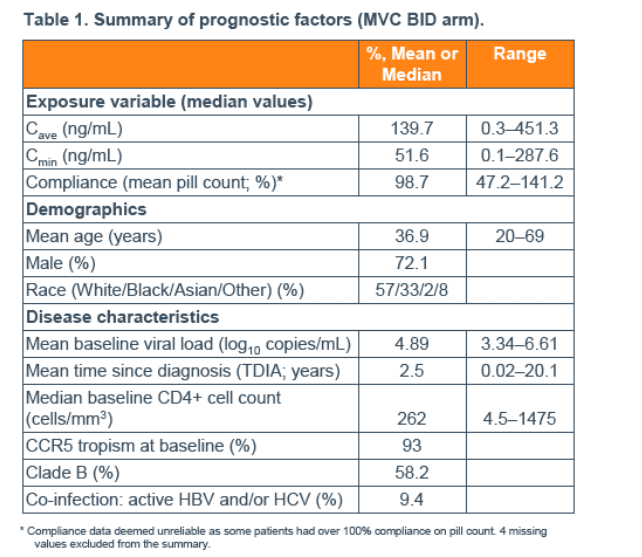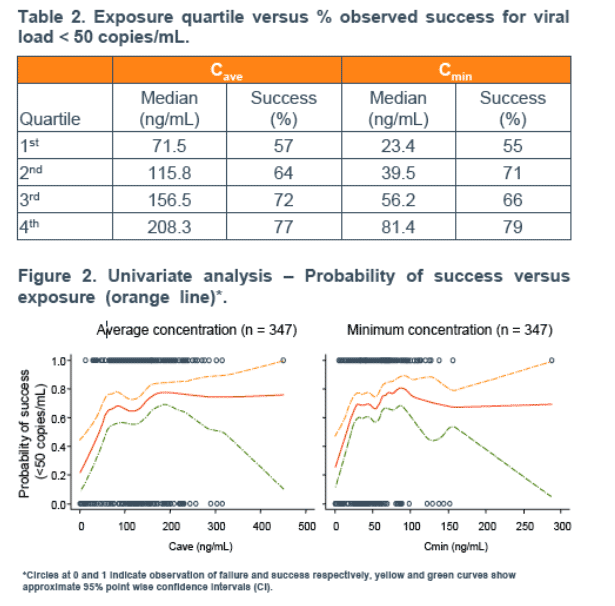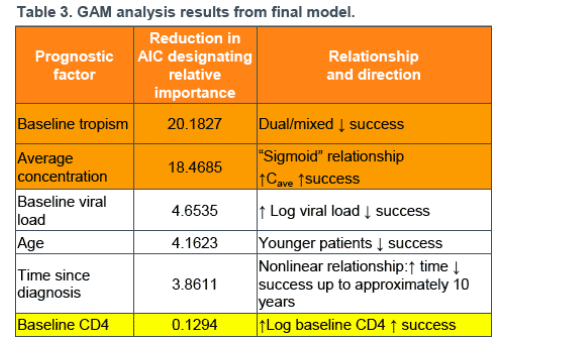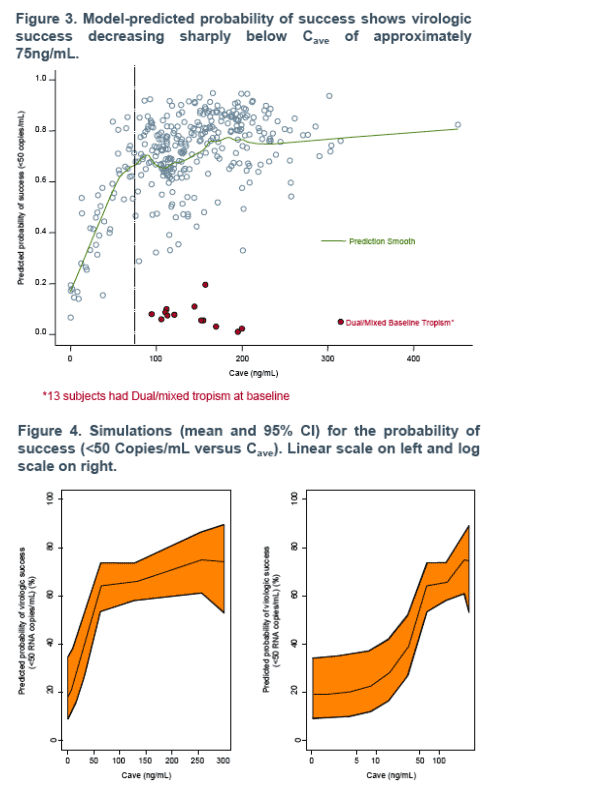 |
 |
 |
| |
Maraviroc Exposure-efficacy (<50 copies/mL) Analysis in HIV-1-infected Treatment-naive Subjects - ITT Population (MERIT Study)
|
| |
| |
Reported by Jules Levin
IAC Mexico City Aug 3-8, 2008
Maraviroc (MVC) is the first CCR5 antagonist approved for use in antiretroviral (ARV) treatment-experienced subjects infected with only CCR5-tropic HIV-1. This approval was based on MVC (QD and BID) plus Optimized Background Therapy (OBT) having shown statistically superior virologic suppression and improvement in CD4 cell count compared with OBT plus placebo in the MOTIVATE 1 and 2 studies [1]. In these studies MVC doses were adjusted from 300mg to 150mg in subjects with potent CYP3A4 inhibitors in their OBT in order to ensure Cmax values did not exceed those seen with 300mg doses in phase 1 studies.
Exposure-response analysis of the combined MOTIVATE studies demonstrated a nonlinear asymptotic sigmoid Emax-type relationship of probability of success (<50 copies/mL) versus MVC average concentration (Cave). This analysis suggested a greater than 80% net probability of success when MVC Cave is 100ng/mL or more, in subjects likely to respond to MVC [2].
MERIT Study Design
MERIT is a Phase 2b/3, 96-week, non-inferiority study comparing MVC 300mg QD and BID with efavirenz (EFV) 600mg QD, in combination with lamivudine plus zidovudine (Combivir) in treatment-naive subjects with only CCR5-tropic HIV-1 infection at screening (Figure 1).
Results of an interim analysis of the first 205 subjects reaching 16 weeks on treatment led to the discontinuation of the QD arm as this did not meet the pre-specified protocol-defined non-inferiority criteria.
MERIT Results (48 week analysis for primary endpoints) [3]
For the data set of all patients who received at least one dose of study treatment, intent-to-treat analysis (ITT) with the lower limit of the 97.5% non-inferiority margin set at 10%:
-- Percentage with viral load <400 copies/mL: Achieved in 70.6% receiving MVC 300mg BID compared to 73.1% receiving EFV. ITT non-inferiority endpoint met (lower bound of 1-sided 97.5% CI - 9.5%).
-- Percentage with viral load <50 copies/mL: Achieved in 65.3% receiving MVC 300mg BID compared to 69.3% receiving EFV. ITT non-inferiority endpoint not met (lower bound of 1-sided 97.5% CI -10.9%).
STUDY OBJECTIVE
To investigate the exposure-response (efficacy) relationship for MVC (300mg BID with Combivir) in ARV treatment-naive subjects, in the context of other prognostic factors.
AUTHOR CONCLUSIONS
MVC exposure (Cave) and CCR5 tropism at baseline were the most significant predictors of success. The exposure-response relationship was nonlinear with a "sigmoid Emax" shape of probability of success versus log Cave. The probability of success decreased sharply below a Cave of approximately 75ng/mL and Cmin of approximately 25ng/mL.
"MVC Cave of about 75ng/mL is associated with 80% probability of a successful response (with Combivir) in treatment-naive subjects with other favorable prognostic factors (not shown)...... Population PK modeling of all MVC PK data from MERIT (including discontinued QD/open label subjects), showed that at least 87% of subjects if given MVC 300mg BID (without drug interactions) would have achieved this average concentration. However, low exposure may be a surrogate for poor adherence. Many (17/46) in the group with Cave less than 75ng/mL had MVC concentrations BLQ on at least one occasion. Such low concentrations are highly unlikely in subjects taking 300mg MVC BID based on modeling of phase 1/2a data with observed dosing."
The relatively small concentration range (only one dose of MVC), the absence of reliable compliance data (only pill counts) and outpatient dosing make it difficult to define the true exposure-response relationship. Low exposure is likely the result of poor adherence in at least some of the subjects, particularly those in the lowest exposure quartile.
Maraviroc 300mg BID in a combination regimen has a high probability of achieving undetectable viral load in treatment-naive subjects infected with only CCR5 virus who are compliant with medication.
METHODS
Data
Endpoint: This analysis started with the full analysis as treated data set and assessed the binary efficacy endpoint (success <50 copies/mL) for the MVC BID arm only. Subjects who discontinued, whatever the reason, were regarded as failures.
Excluded Subjects: 13 of 360 subjects in the MVC BID arm had no MVC concentrations and were excluded from all analyses; a further 7 were missing one or more covariates of interest and were excluded from the GAM analyses.
Exposure variables: Cave and Cmin, were derived from post hoc pharmacokinetic (PK) parameters obtained from population pharmacokinetic modeling with NONMEM, using sparse PK concentrations taken over 48 weeks [4]. Two samples were obtained at weeks 2 and 48 with single samples obtained at other visits (1-12 samples/subject). PK concentrations below the limit of quantification (BLQ) were retained but set to 0.25ng/mL (half BLQ). The exposure variables for each individual are thus based on all available PK samples over 48 weeks and may reflect poor adherence. Dosing times were those reported by patients.
Analyses
Exploratory analyses:
--Graphical univariate analysis (S-PLUS)
--Quartile (exposure) versus observed success rates
--Step-wise generalized additive logistic modeling (GAM) (S-PLUS)
--Akaike Information Criterion (AIC) used to assess significance
--model evaluation using bootstrapping and predictive checks (not
shown)
--simulation of the exposure response relationship.

RESULTS
Exploratory analysis
Table 2 and Figure 2 illustrate that observed success and predicted probability of success increase with increasing MVC Cave/Cmin in an asymptotic fashion. A sharp fall in probability of success is seen below a Cave of approximately 75ng/mL or Cmin of 25ng/mL (Figure 2).

GAM analysis
The two most significant predictors of efficacy were tropism at baseline and Cave (Table 3).
A second less important group (based on AIC changes) were baseline viral load, age and time since diagnosis in decreasing order.
Surprisingly, the CD4+ cell count at baseline, a recognized marker of disease progression, was the least important covariate identified by a small change in AIC. This may be the result of information on disease progression being taken into account by other factors including baseline tropism, baseline viral load and time since diagnosis.
Neither race nor sex were significant predictors of efficacy.

Exposure-response relationship
An asymptotic sigmoid relationship between probability of success and both log Cmin and Cave was apparent. The AIC changes favored Cave as the slightly better prognostic factor. Probability of success decreased very sharply below MVC Cave of approximately 75ng/mL (Figures 3 and 4) and a Cmin of 25ng/mL (not shown).
MVC Cave of about 75ng/mL is associated with 80% probability of a successful response (with Combivir) in treatment-naive subjects with other favorable prognostic factors (not shown).
Population PK modeling of all MVC PK data from MERIT (including discontinued QD/open label subjects), showed that at least 87% of subjects if given MVC 300mg BID (without drug interactions) would have achieved this average concentration. However, low exposure may be a surrogate for poor adherence. Many (17/46) in the group with Cave less than 75ng/mL had MVC concentrations BLQ on at least one occasion. Such low concentrations are highly unlikely in subjects taking 300mg MVC BID based on modeling of phase 1/2a data with observed dosing.

REFERENCES
1. Hardy D, et.al. 15th CROI 2008. Poster 792.
2. McFadyen L, et al. 11th EACS 2007. Poster P4.1/06
3. Saag M, et. al. 4th IAS 2007. Abstract WESS104.
4. Weatherley B, et al. 9th International Workshop on Clinical Pharmacology of HIV
Therapy, 2008. Poster 17B.
|
| |
|
 |
 |
|
|